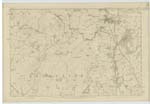OS1/3/1/9
| List of names as written | Various modes of spelling | Authorities for spelling | Situation | Description remarks |
|---|---|---|---|---|
| FORT [Knock Jargon] | Site of a Fort Site of a Fort Site of a Fort |
Alexander Ritchie Hugh Motion John Crawford |
011 | This feature, situated on Knock Jargon is supposed to be the remains of an ancient fortification or Camp. There are two openings on the south side, Though tradition has preserved no information con- cerning the persons who designed it. Comparing it with others similarly constructed in various parts of the country it is probable that this construction intended as it may have been is of Danish origin. |
Continued entries/extra info
[Page] 9Sheet 011.5. Trace 6 Ph. [Parish] of Ardrossan -- Co. [County] Ayr
From its form many Believe this to have been
a Danish strength; but the same reason would
also assign it to the old Britons; and we are the more
inclined to attribute it to them, because of the par-
allelogram which tops an adjacent eminence. see page 41.
Paterson's Hist. [History] of Ayr
"On Knock-georgian are still distinctly
"to be seen the remains of an ancient Camp
"or fortification, particularly the ramparts
"and gateways. From its circular form it is
"generally supposed to be Danish"
New Stat [Statistical] Acct [ Account]
"About 3 miles to the north of Saltcoats is Knockjirgan, or Knockjerigan,
"a hill, in ancient times a Roman Beacon post. A double line of
"fortification is still visible round the summit of the hill, which possesses a most commanding view
"of the entrance to the Frith of Clyde, and of the country in every direction. The line of beacon hills
"were Knockjirgan, Loudon Hill, Caldwell Law, Campsie Fells, and Stirling Castle."
Itinerary of Scotland
Page 34
Transcribers who have contributed to this page.
Nellie- Moderator
Location information for this page.
Linked mapsheets.




